Moringa oleifera
Moringa oleifera is a fast-growing, drought-resistant tree of the family Moringaceae, native to the Indian subcontinent.[2] Common names include moringa,[3] drumstick tree[3] (from the long, slender, triangular seed-pods), horseradish tree[3] (from the taste of the roots, which resembles horseradish), and ben oil tree or benzolive tree[3] (from the oil which is derived from the seeds).
| Moringa oleifera | |
|---|---|
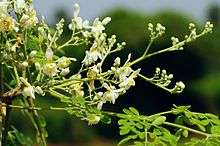 | |
| Scientific classification | |
| Kingdom: | Plantae |
| Clade: | Tracheophytes |
| Clade: | Angiosperms |
| Clade: | Eudicots |
| Clade: | Rosids |
| Order: | Brassicales |
| Family: | Moringaceae |
| Genus: | Moringa |
| Species: | M. oleifera |
| Binomial name | |
| Moringa oleifera | |
| Synonyms[1] | |
| |
It is widely cultivated for its young seed pods and leaves used as vegetables and for traditional herbal medicine. It is also used for water purification.[4][5] Although listed as an invasive species in several countries, M. oleifera has "not been observed invading intact habitats or displacing native flora", and so "should be regarded at present as a widely cultivated species with low invasive potential." [2]
Description
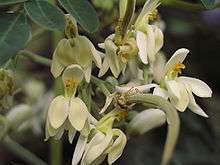
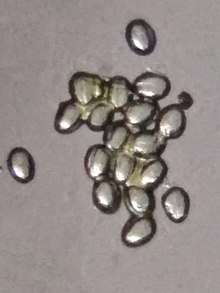
%2C_Philippines.jpg)
M. oleifera is a fast-growing, deciduous tree[6] that can reach a height of 10–12 m (32–40 ft) and trunk diameter of 45 cm (1.5 ft).[7] The bark has a whitish-grey colour and is surrounded by thick cork. Young shoots have purplish or greenish-white, hairy bark. The tree has an open crown of drooping, fragile branches and the leaves build up a feathery foliage of tripinnate leaves.
The flowers are fragrant and hermaphroditic, surrounded by five unequal, thinly veined, yellowish-white petals. The flowers are about 1.0–1.5 cm (1/2") long and 2.0 cm (3/4") broad. They grow on slender, hairy stalks in spreading or drooping flower clusters which have a length of 10–25 cm.[7]
Flowering begins within the first six months after planting. In seasonally cool regions, flowering only occurs once a year between April and June. In more constant seasonal temperatures and with constant rainfall, flowering can happen twice or even all year-round.[7]
The fruit is a hanging, three-sided brown capsule of 20–45 cm size which holds dark brown, globular seeds with a diameter around 1 cm. The seeds have three whitish papery wings and are dispersed by wind and water.[7]
In cultivation, it is often cut back annually to 1–2 m (3–6 ft) and allowed to regrow so the pods and leaves remain within arm's reach.[7]
Taxonomy
French botanist François Alexandre Pierre de Garsault described the species as Balanus myrepsica, however his names are not accepted as valid as he did not always give his descriptions binomial names.[8]
French naturalist Jean-Baptiste Lamarck described the species in 1785.[9] Moringa derives from a Tamil word, murungai, meaning "twisted pod", alluding to the young fruit.[10] The species name is derived from the Latin words oleum "oil" and ferre "to bear".[8] A combined analysis of morphology and DNA shows that M. oleifera is most closely related to M. concanensis, and the common ancestor of these two diverged from the lineage of M. peregrina.[11]
Cultivation
The moringa tree is grown mainly in semiarid, tropical, and subtropical areas, corresponding in the United States to USDA hardiness zones 9 and 10. It tolerates a wide range of soil conditions, but prefers a neutral to slightly acidic (pH 6.3 to 7.0), well-drained sandy or loamy soil.[12] In waterlogged soil, the roots have a tendency to rot.[12] Moringa is a sun- and heat-loving plant, and does not tolerate freezing or frost. Moringa is particularly suitable for dry regions, as it can be grown using rainwater without expensive irrigation techniques.
| Parameter | Requirement/range[12] |
|---|---|
| Climate | Grows best in tropical or subtropical |
| Altitude | 0 – 2000 m |
| Rainfall | 250 – 3000 mm
Irrigation needed for leaf production if rainfall < 800 mm |
| Soil Type | Loamy, sandy, or sandy-loam |
| Soil pH | pH 5 – 9 |
Production area
India is the largest producer of moringa, with an annual production of 1.2 million tonnes of fruits from an area of 380 km².[12]
Moringa is grown in home gardens and as living fences in South Asia and Southeast Asia, where it is commonly sold in local markets. In the Philippines and Indonesia, it is commonly grown for its leaves which are used as food. Moringa is also actively cultivated by the World Vegetable Center in Taiwan, a center for vegetable research.
More generally, moringa grows in the wild or is cultivated in Central America and the Caribbean, northern countries of South America, Africa, South & Southeast Asia and various countries of Oceania.
As of 2010, cultivation in Hawaii, for commercial distribution in the United States, was in its early stages.[12]
Cultivation practice
Soil preparations
In tropical cultivation, soil erosion is a major problem. Therefore, the soil treatment has to be as shallow as possible. Plowing is required only for high planting densities. In low planting densities, "it is better to dig pits and refill them with the soil. This ensures good root system penetration without causing too much land erosion. The pits must be 30 to 50 cm deep, and 20 to 40 cm wide."
Propagation
Moringa can be propagated from seed or cuttings. Direct seeding is possible because the germination rate of M. oleifera is high. Moringa seeds can be germinated year-round in well-draining soil. Cuttings of 1 m length and at least 4 cm diameter can be used for vegetative propagation.
Planting
For intensive leaf production, "the spacing of plants should be 15 x 15 cm or 20 x 10 cm, with conveniently spaced alleys (for example: every 4 m) to facilitate plantation management and harvests."[13] Weeding and disease prevention are difficult because of the high density. In a semi-intensive production, the plants are spaced 50 cm to 1 m apart. This gives good results with less maintenance.
Moringa trees can also be cultivated in alleys, as natural fences and associated with other crops. The distance between moringa rows in an agroforestry cultivation is usually between 2 and 4 m.
Breeding
In India, from where moringa most likely originated, the diversity of wild types is large. This gives a good basis for breeding programs. In countries where moringa has been introduced, the diversity is usually much smaller among the cultivar types. Locally well-adapted wild types, though, can be found in most regions.
Because moringa is cultivated and used in different ways, there are different breeding aims. The breeding aims for an annual or a perennial plant are obviously different. The yield stability of fruits is an important breeding aim for the commercial cultivation in India, where moringa is cultivated as an annual. On less favorable locations, perennial cultivation has big advantages. Erosion is much smaller with perennial cultivation. In Pakistan, varieties have been tested for their nutritional composition of the leaves on different locations.[14] The different breeding aims result in a different selection. India selects for a higher number of pods and dwarf or semidwarf varieties. Breeders in Tanzania, though, are selecting for higher oil content.
Yield and harvest
M. oleifera can be cultivated for its leaves, pods, and/or its kernels for oil extraction and water purification. The yields vary widely, depending on season, variety, fertilization, and irrigation regimen. Moringa yields best under warm, dry conditions with some supplemental fertilizer and irrigation.[12] Harvest is done manually with knives, sickles, and stabs with hooks attached.[12] Pollarding, coppicing, and lopping or pruning are recommended to promote branching, increase production, and facilitate harvesting.[15]
Fruits
When the plant is grown from cuttings, the first harvest can take place 6–8 months after planting. Often, the fruits are not produced in the first year, and the yield is generally low during the first few years. By year two, it produces around 300 pods, by year three around 400–500. A good tree can yield 1000 or more pods.[16] In India, a hectare can produce 31 tons of pods per year.[12] Under North Indian conditions, the fruits ripen during the summer. Sometimes, particularly in South India, flowers and fruit appear twice a year, so two harvests occur, in July to September and March to April.[17]
Leaves
Average yields of 6 tons/ha/year in fresh matter can be achieved. The harvest differs strongly between the rainy and dry seasons, with 1120 kg/ha per harvest and 690 kg/ha per harvest, respectively. The leaves and stems can be harvested from the young plants 60 days after seeding and then another seven times in the year. At every harvest, the plants are cut back to within 60 cm of the ground.[18] In some production systems, the leaves are harvested every 2 weeks.
The cultivation of M. oleifera can also be done intensively with irrigation and fertilization with suitable varieties.[13] Trials in Nicaragua with 1 million plants per hectare and 9 cuttings/year over 4 years gave an average fresh matter production of 580 metric tons/ha/year, equivalent to about 174 metric tons of fresh leaves.[13]
Oil
One estimate for yield of oil from kernels is 250 l/ha.[12] The oil can be used as a food supplement, as a base for cosmetics, and for hair and the skin.
Pests and diseases
The moringa tree is not affected by any serious diseases in its native or introduced ranges. In India, several insect pests are seen, including various caterpillars such as the bark-eating caterpillar, the hairy caterpillar or the green leaf caterpillar. The budworms Noctuidae are known to cause serious defoliation. Damaging agents can also be aphids, stem borers, and fruit flies. In some regions, termites can also cause minor damage. If termites are numerous in soils, insects management costs are not bearable.[7]
The moringa tree is a host to Leveillula taurica, a powdery mildew which causes damage in papaya crops in south India. Cultivation management should therefore be checked.
Nutrients
| Nutritional value per 100 g (3.5 oz) | |
|---|---|
| Energy | 64 kcal (270 kJ) |
8.28 g | |
| Dietary fiber | 2.0 g |
1.40 g | |
9.40 g | |
| Vitamins | Quantity %DV† |
| Vitamin A equiv. | 47% 378 μg |
| Thiamine (B1) | 22% 0.257 mg |
| Riboflavin (B2) | 55% 0.660 mg |
| Niacin (B3) | 15% 2.220 mg |
| Pantothenic acid (B5) | 3% 0.125 mg |
| Vitamin B6 | 92% 1.200 mg |
| Folate (B9) | 10% 40 μg |
| Vitamin C | 62% 51.7 mg |
| Minerals | Quantity %DV† |
| Calcium | 19% 185 mg |
| Iron | 31% 4.00 mg |
| Magnesium | 41% 147 mg |
| Manganese | 17% 0.36 mg |
| Phosphorus | 16% 112 mg |
| Potassium | 7% 337 mg |
| Sodium | 1% 9 mg |
| Zinc | 6% 0.6 mg |
| Other constituents | Quantity |
| Water | 78.66 g |
| |
| †Percentages are roughly approximated using US recommendations for adults. Source: USDA Nutrient Database | |
| Nutritional value per 100 g (3.5 oz) | |
|---|---|
| Energy | 37 kcal (150 kJ) |
8.53 g | |
| Dietary fiber | 3.2 g |
0.20 g | |
2.10 g | |
| Vitamins | Quantity %DV† |
| Vitamin A equiv. | 1% 4 μg |
| Thiamine (B1) | 5% 0.0530 mg |
| Riboflavin (B2) | 6% 0.074 mg |
| Niacin (B3) | 4% 0.620 mg |
| Pantothenic acid (B5) | 16% 0.794 mg |
| Vitamin B6 | 9% 0.120 mg |
| Folate (B9) | 11% 44 μg |
| Vitamin C | 170% 141.0 mg |
| Minerals | Quantity %DV† |
| Calcium | 3% 30 mg |
| Iron | 3% 0.36 mg |
| Magnesium | 13% 45 mg |
| Manganese | 12% 0.259 mg |
| Phosphorus | 7% 50 mg |
| Potassium | 10% 461 mg |
| Sodium | 3% 42 mg |
| Zinc | 5% 0.45 mg |
| Other constituents | Quantity |
| Water | 88.20 g |
| |
| †Percentages are roughly approximated using US recommendations for adults. Source: USDA Nutrient Database | |
Almost all parts of moringa are edible,[2] with regional uses varying widely:
- Immature seed pods, called "drumsticks"
- Leaves
- Mature seeds
- Oil pressed from seeds
- Flowers
- Roots
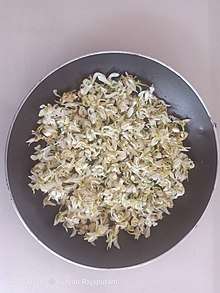
Leaves
Nutritional content of 100 g of fresh M. oleifera leaves (about 5 cups) is shown in the table (right; USDA data), while other studies of nutrient values are available.[19]
The leaves are the most nutritious part of the plant, being a significant source of B vitamins, vitamin C, provitamin A as beta-carotene, vitamin K, manganese, and protein.[20][21] When compared with common foods particularly high in certain nutrients per 100 g fresh weight, cooked moringa leaves are considerable sources of these same nutrients. Some of the calcium in moringa leaves is bound as crystals of calcium oxalate[22] though at levels 1/25th to 1/45th of that found in spinach, which is a negligible amount. The leaves are cooked and used like spinach, and are commonly dried and crushed into a powder used in soups and sauces[2] or as a supplement for pets.
Drumsticks
The immature seed pods, called "drumsticks", are commonly consumed in South Asia. They are prepared by parboiling, and cooked in a curry until soft.[23] The seed pods/fruits, even when cooked by boiling, remain particularly high in vitamin C[24] (which may be degraded variably by cooking) and are also a good source of dietary fiber, potassium, magnesium, and manganese.[24]
Seeds
The seeds, sometimes removed from more mature pods and eaten like peas or roasted like nuts, contain high levels of vitamin C and moderate amounts of B vitamins and dietary minerals.
Seed oil
Mature seeds yield 38–40% edible oil called ben oil from its high concentration of behenic acid. The refined oil is clear and odorless, and resists rancidity. The seed cake remaining after oil extraction may be used as a fertilizer or as a flocculent to purify water.[25] Moringa seed oil also has potential for use as a biofuel.[26] Using the cold press method (under 132 degrees F) only yields 14% which is about the same amount of yield in a raw press using no heat whatsoever.
Roots
The roots are shredded and used as a condiment with sharp flavor qualities deriving from significant content of polyphenols.[27]
Malnutrition relief
Moringa trees have been used to combat malnutrition, especially among infants and nursing mothers.[28] Since moringa thrives in arid and semiarid environments, it may provide a versatile, nutritious food source throughout the year.[29] Moringa leaves have been proposed as an iron-rich food source (31% Daily Value per 100 g consumed, table) to combat iron deficiency.[30] However, further study is needed to test practical applications of using this dietary source and its iron bioavailability.
Culinary uses
M. oleifera has numerous applications in cooking throughout its regional distribution. Edible parts of the plant include the whole leaves (leaflets, stalks and stems); the immature, green fruits or seed pods; the fragrant flowers; and the young seeds and roots.[31]
Fruit pods
The young, slender fruits, commonly known as "drumsticks", are prepared as a culinary vegetable, often cut into shorter lengths and stewed in curries and soups. The taste is described as reminiscent of asparagus,[32] with a hint of green beans, though sweeter, from the immature seeds contained inside.[33]
In India and Bangladesh, drumstick curries are commonly prepared by boiling immature pods to the desired level of tenderness in a mixture of coconut milk and spices (such as poppy or mustard seeds).[31] The fruit is a common ingredient in dals and lentil soups, such as drumstick dal and sambar, where it is pulped first, then simmered with other vegetables and spices like turmeric and cumin. Mashed drumstick pulp commonly features in bhurta, a mixture of lightly fried or curried vegetables.[31]
Because the outer skin is tough and fibrous, drumsticks are often chewed to extract the juices and nutrients, with the remaining fibrous material discarded. Others describe a slightly different method of sucking out the flesh and tender seeds and discarding the tube of skin.[33]
Leaves
The leaves can be used in many ways, perhaps most commonly added to clear broth-based soups, such as the Filipino dishes tinola and utan. Tender moringa leaves, finely chopped, are used as garnish for vegetable dishes and salads, such as the Kerala dish thoran. It is also used in place of or along with coriander.[31]
For long-term use and storage, moringa leaves may be dried and powdered to preserve their nutrients. Sun, shade, freeze and oven drying at 50–60 °C are all acceptable methods, albeit variable in their retention efficacy of specific micro- and macronutrients.[34][35] The powder is commonly added to soups, sauces and smoothies.[31] Owing to its high nutritional density, moringa leaf powder is valued as a dietary supplement and may be used to enrich food products ranging from dairy, such as yogurt and cheese,[36] to baked goods, such as bread and pastries,[31][36] with acceptable sensory evaluation.[31][36]
Seeds
In Nigeria, the seeds are prized for their bitter flavor; they are commonly added to sauces or eaten as a fried snack. The edible seed oil may be used in condiments or dressings.[31]
Ground, debittered moringa seed is suitable as a fortification ingredient to increase the protein, iron and calcium content of wheat flours.[31][36][37]
- Dunt-dalun chin-yei, Burmese drumstick sour soup
- Traditional Thai kaeng som with drumstick pods and fresh pla thu
 Bread in Benin with moringa powder as one of the ingredients
Bread in Benin with moringa powder as one of the ingredients.jpg) Sabaw sa kalamunggay, a Visayan fish soup from the Philippines with moringa leaves
Sabaw sa kalamunggay, a Visayan fish soup from the Philippines with moringa leaves
Traditional medicine and research
The bark, sap, roots, leaves, seeds and flowers are used in traditional medicine.[2][38]
Research has examined how it might affect blood lipid profiles and insulin secretion.[39] Extracts from leaves contain various polyphenols, which are under basic research to determine their potential effects in humans.[40] Despite considerable preliminary research to determine if moringa components have bioactive properties, there are no controlled clinical studies to determine whether it has any effect on health or diseases.[39]
Potential adverse effects
Toxicity data in humans is limited, although lab studies indicate that certain compounds in the bark and roots or their extracts may cause adverse effects when consumed in excess.[39] Supplementation with M. oleifera leaf extract is potentially toxic at levels exceeding 3,000 mg/kg of body weight but safe at levels below 1,000 mg/kg.[41] M. oleifera is contraindicated during pregnancy, may interfere with prescription drugs affecting cytochrome P450 (including CYP3A4) and may inhibit the anti-hyperglycemic effect of sitagliptin.[39]
Other uses
In developing countries, moringa has the potential to improve nutrition, boost food security, foster rural development, and support sustainable landcare.[2][42] It may be used as forage for livestock, a micronutrient liquid, a natural anthelmintic, and possible adjuvant.[43][44]
Moringa oleifera leaf powder was as effective as soap for hand washing when wetted in advance to enable anti-septic and detergent properties from phytochemicals in the leaves.[45] Moringa oleifera seeds and press cake have been implemented as wastewater conditioners for dewatering and drying fecal sludge.[46]
Water purification
Moringa seed cake, obtained as a byproduct of pressing seeds to obtain oil, is used to filter water using flocculation to produce potable water for animal or human consumption.[47][48] Moringa seeds contain dimeric cationic proteins[49] which absorb and neutralize colloidal charges in turbid water, causing the colloidal particles to clump together, making the suspended particles easier to remove as sludge by either settling or filtration. Moringa seed cake removes most impurities from water. This use is of particular interest for being nontoxic and sustainable compared to other materials in moringa-growing regions where drinking water is affected by pollutants.[48]
Gallery
_at_Jayanti%2C_Duars%2C_West_Bengal_W_IMG_5249.jpg) Branch of a fully grown moringa tree with flowers and leaves in West Bengal
Branch of a fully grown moringa tree with flowers and leaves in West Bengal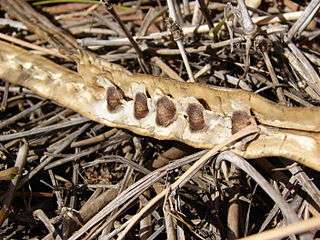 Dried moringa with pods and seeds on the ground in Hawaii
Dried moringa with pods and seeds on the ground in Hawaii
References
- Olson, M. E. (2010). Flora of North America Committee (ed.). eFlora summary: Moringaceae: Drumstick Family. Flora of North America, North of Mexico. 7. New York and Oxford. pp. 167–169.
- "Moringa oleifera (horseradish tree)". CABI. 17 December 2019. Retrieved 17 May 2020.
- "Moringa oleifera, Moringa oleifera". Germplasm Resources Information Network (GRIN). Agricultural Research Service (ARS), United States Department of Agriculture (USDA). Retrieved 11 December 2017.
- Kalibbala, H. M.; Wahlberg, O.; Hawumba, T. J. (1 December 2009). "The impact of Moringa oleifera as a coagulant aid on the removal of trihalomethane (THM) precursors and iron from drinking water". Water Science and Technology: Water Supply. 9 (6): 707–714. doi:10.2166/ws.2009.671.
- Mpagi., Kalibbala, Herbert (2012). Removal of natural organic matter and control of trihalomethanes formation in water treatment. Stockholm: Architecture and the Built Environment, KTH Royal Institute of Technology. ISBN 9789175013237. OCLC 939795543.
- "Horseradish tree". Encyclopædia Britannica. Retrieved 25 April 2015.
- Parotta, John A. (1993). "Moringa oleifera Lam. Reseda, horseradish tree. Moringaceae. Horseradish tree family" (PDF). USDA Forest Service, International Institute of Tropical Forestry. Retrieved 20 November 2013.
- "Moringa oleifera". Flora of Australia Online. Department of the Environment and Heritage, Australian Government.
- Lamarck, Jean-Baptiste (1785). Encyclopédie méthodique. Botanique. Paris: Panckoucke; Plomteux. p. 398.
- Olson, Mark E (2010). Moringaceae Martinov; Drumstick Tree Family; In: Flora of North America, North of Mexico, Volume 7: Magnoliophyta: Dilleniidae, Part 2. Oxford University Press. p. 168. ISBN 978-0195318227.
- Olson, Mark E. (2002). "Combining Data from DNA Sequences and Morphology for a Phylogeny of Moringaceae (Brassicales)" (PDF). Systematic Botany. 27 (1): 55–73. doi:10.1043/0363-6445-27.1.55 (inactive 22 June 2020).
- Radovich, Ted (2011). C.R. Elevitch (ed.). "Farm and Forestry Production and Marketing Profile for Moringa (revised February 2011)" (PDF). In: Specialty Crops for Pacific Island Agroforestry.
- Amaglo, N. (2006). "How to Produce Moringa Leaves Efficiently?" (PDF). Retrieved 19 November 2013.
- Iqbal, Shahid; Bhanger, M.I. (2006). "Effect of season and production location on antioxidant activity of Moringa oleifera leaves grown in Pakistan". Journal of Food Composition and Analysis. 19 (6–7): 544–551. doi:10.1016/j.jfca.2005.05.001.
- Grubben, G (2004). Grubben, G. J. H. (ed.). Vegetables. 2 (Plant resources of tropical Africa ed.). p. 394. ISBN 978-9057821479. Retrieved 2 February 2015.
- Booth, F.E.M.; Wickens, G.E., 1988: Non-timber Uses of Selected Arid Zone Trees and Shrubs in Africa, p.98, FAO, Rome "".Retrieved 20-11-2013.
- Ramachandran, C.; Peter, K. V.; Gopalakrishnan, P. K. (1980). "Drumstick (Moringa oleifera): A multipurpose Indian vegetable". Economic Botany. 34 (3): 276–283. doi:10.1007/BF02858648. S2CID 40029228.
- Sogbo, K. A. (2006). "Moringa Leaf Farming Systems: Conditions for Profitability and Sustainability" (PDF). Retrieved 19 November 2013.
- Gopalan, C.; Rama Sastri, B. V.; Balasubramanian, S. C. (1971). Nutritive Value of Indian Foods. Hyderabad: National Institute of Nutrition, Indian Council of Medical Research. pp. 66, 78. OCLC 2387900.
- "Horseradish-tree, leafy tips, cooked, boiled, drained, without salt". Nutritiondata.com. Condé Nast. 2012. Retrieved 6 May 2013.
- Peter, K.V. (2008). Underutilized and Underexploited Horticultural Crops:, Volume 4. New India Publishing. p. 112. ISBN 978-81-89422-90-5.
- Olson, M. E.; Carlquist, S. (2001). "Stem and root anatomical correlations with life form diversity, ecology, and systematics in Moringa (Moringaceae)". Botanical Journal of the Linnean Society. 135 (4): 315–348. doi:10.1111/j.1095-8339.2001.tb00786.x.
- Schneider, Elizabeth (2001). Vegetables from Amaranth to Zucchini: The Essential Reference. HarperCollins. p. 318. ISBN 978-0-688-15260-4.
- "Horseradish-tree, pods, cooked, boiled, drained, without salt". Nutritiondata.com. Condé Nast. 2012. Retrieved 6 May 2013.
- Lea, Michael (2010). Bioremediation of Turbid Surface Water Using Seed Extract from Moringa oleifera Lam. (Drumstick) Tree. Current Protocols in Microbiology. Chapter 1. pp. Unit1G.2. doi:10.1002/9780471729259.mc01g02s16. ISBN 978-0471729259. PMID 20131221.
- Rashid, Umer; Anwar, Farooq; Moser, Bryan R.; Knothe, Gerhard (2008). "Moringa oleifera oil: A possible source of biodiesel". Bioresource Technology. 99 (17): 8175–9. doi:10.1016/j.biortech.2008.03.066. PMID 18474424.
- Atawodi, S. E.; Atawodi, J. C.; Idakwo, G. A.; Pfundstein, B; Haubner, R; Wurtele, G; Bartsch, H; Owen, R. W. (2010). "Evaluation of the polyphenol content and antioxidant properties of methanol extracts of the leaves, stem, and root barks of Moringa oleifera Lam". Journal of Medicinal Food. 13 (3): 710–6. doi:10.1089/jmf.2009.0057. PMID 20521992.
- Kumar, H. D. (1 January 2004). "Management of Nutritional and Health Needs of Malnourished and Vegetarian People in India". In Cooper, Edwin L.; Yamaguchi, Nobuo (eds.). Complementary and Alternative Approaches to Biomedicine. Advances in Experimental Medicine and Biology. 546. Springer US. pp. 311–321. doi:10.1007/978-1-4757-4820-8_23. ISBN 978-1-4419-3441-3. PMID 15584384.
- "Traditional Crop of the Month". FAO. Retrieved 25 April 2015.
- Oduro I, Ellis WO, Owusu D (2008). "Nutritional potential of two leafy vegetables: Moringa oleifera and Ipomoea batatas leaves". Scientific Research and Essay. 3 (2).
- Lim, TK (2012). "Moringa oleifera". Edible Medicinal And Non Medicinal Plants. 3, Fruits. Springer Netherlands. pp. 453–485. ISBN 978-94-007-2534-8.
- Holmer, R; Linwattana, G; Nath, P; Keatinge, JDH (2013). SEAVEG 2012: High Value Vegetables in Southeast Asia: Production, Supply and Demand. World Vegetable Center. ISBN 978-9290582007.
- "My Mom Cooked Moringa Before It Was A Superfood" (Podcast). NPR. 21 September 2015. Retrieved 8 July 2017.
- Adenike AB (2014). "The effects of drying on some nutrients of Moringa oleifera leaves" (PDF). Annals – Food Science and Technology. 15 (2): 246–250. ISSN 2344-4916.
- Ali, A; Yusof, YA; Chin, NL; Ibrahim, MN (2017). "Processing of Moringa leaves as natural source of nutrients by optimization of drying and grinding mechanism". Journal of Food Process Engineering. 40 (e12583): e12583. doi:10.1111/jfpe.12583.
- Oyeyinka, AT; Oyeyinka, SA (2018). "Moringa oleifera as a food fortificant: Recent trends and prospects". Journal of the Saudi Society of Agricultural Sciences. 17 (2): 127–136. doi:10.1016/j.jssas.2016.02.002.
- Chinma, C; Abu, J; Akoma, S (2014). "Effect of germinated tigernut and moringa flour blends on the quality of wheat-based bread". Journal of Food Processing and Preservation. 38 (2): 721–727. doi:10.1111/jfpp.12023.
- NPCS Board (2012). Handbook on Agro Based Industries (2nd Revised ed.). Niir Project Consultancy Services. p. 66. ISBN 978-9381039120.
- "Moringa oleifera". Memorial Sloan-Kettering Cancer Center. Retrieved 27 February 2014.
- Sreelatha, S.; Padma, P. R. (11 November 2009). "Antioxidant activity and total phenolic content of Moringa oleifera leaves in two stages of maturity". Plant Foods for Human Nutrition. 64 (4): 303–311. doi:10.1007/s11130-009-0141-0. PMID 19904611. S2CID 8801347.
- Asare, GA; Nyarko, A (2012). "Toxicity potentials of the nutraceutical Moringa oleifera at supra-supplementation levels". Journal of Ethnopharmacology. 139 (1): 265–272. doi:10.1016/j.jep.2011.11.009. PMID 22101359.
- National Research Council (27 October 2006). "Moringa". Lost Crops of Africa: Volume II: Vegetables. Lost Crops of Africa. 2. National Academies Press. ISBN 978-0-309-10333-6. Retrieved 15 July 2008.
- Makkar HP, Francis G, Becker K (2007). "Bioactivity of phytochemicals in some lesser-known plants and their effects and potential applications in livestock and aquaculture production systems". Animal. 1 (9): 1371–91. doi:10.1017/S1751731107000298. PMID 22444893.
- Mahajan SG, Mali RG, Mehta AA (2007). "Protective effect of ethanolic extract of seeds of Moringa oleifera Lam. against inflammation associated with development of arthritis in rats". J Immunotoxicol. 4 (1): 39–47. doi:10.1080/15476910601115184. PMID 18958711.
- Torondel, B.; Opare, D.; Brandberg, B.; Cobb, E.; Cairncross, S. (2014). "Efficacy of Moringa oleifera leaf powder as a hand- washing product: A crossover controlled study among healthy volunteers". BMC Complementary and Alternative Medicine. 14: 57. doi:10.1186/1472-6882-14-57. PMC 3930822. PMID 24528477.
- Gold, Moritz; Dayer, Pauline; Faye, Marie Christine Amie Sene; Clair, Guillaume; Seck, Alsane; Niang, Seydou; Morgenroth, Eberhard; Strande, Linda (18 April 2016). "Locally produced natural conditioners for dewatering of faecal sludge". Environmental Technology. 37 (21): 2802–2814. doi:10.1080/09593330.2016.1165293. PMC 5020332. PMID 26984372.
- Ndabigengesere, Anselme; Narasiah, K.Subba; Talbot, Brian G. (February 1995). "Active agents and mechanism of coagulation of turbid waters using Moringa oleifera". Water Research. 29 (2): 703–710. doi:10.1016/0043-1354(94)00161-Y.
- Hellsing, Maja S.; Kwaambwa, Habauka M.; Nermark, Fiona M.; Nkoane, Bonang B.M.; Jackson, Andrew J.; Wasbrough, Matthew J.; Berts, Ida; Porcar, Lionel; Rennie, Adrian R. (2013). "Structure of flocs of latex particles formed by addition of protein from Moringa seeds". Colloids and Surfaces A: Physicochemical and Engineering Aspects. 460: 460–467. doi:10.1016/j.colsurfa.2013.11.038.
- Ghebremichael, K. A.; Gunaratna, K. R.; Henriksson, H; Brumer, H; Dalhammar, G (2005). "A simple purification and activity assay of the coagulant protein from Moringa oleifera seed". Water Res. 39 (11): 2338–44. doi:10.1016/j.watres.2005.04.012. PMID 15921719.
External links
| Wikimedia Commons has media related to Moringa oleifera. |
| Wikispecies has information related to Moringa oleifera |
- Dressler, S.; Schmidt, M. & Zizka, G. (2014). "Moringa oleifera". African plants – a Photo Guide. Frankfurt/Main: Forschungsinstitut Senckenberg.